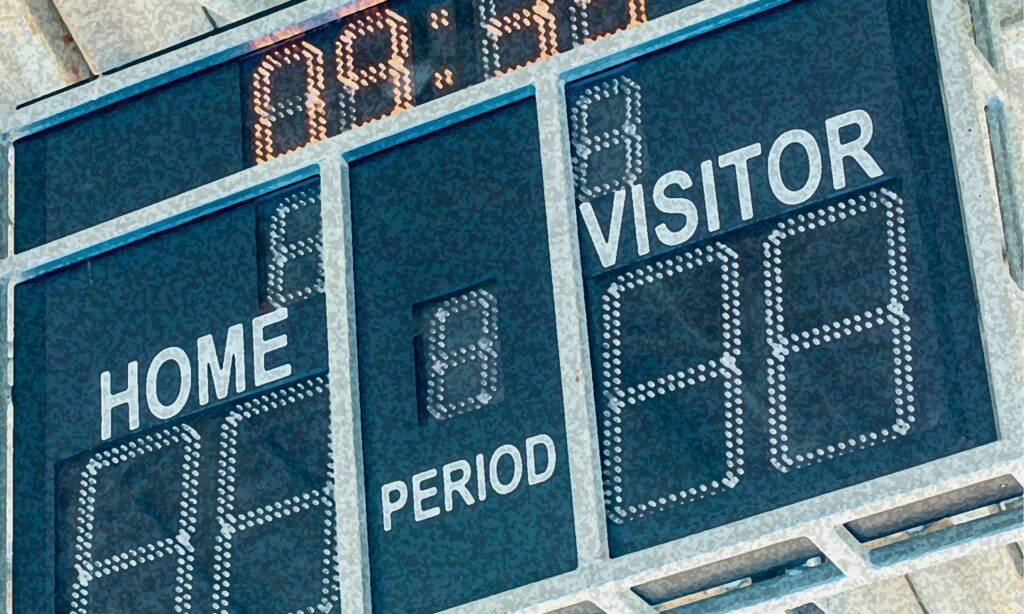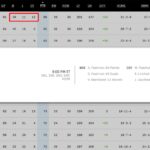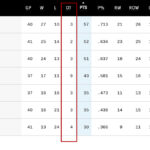Olympic Hockey is governed by the International Ice Hockey Federation (IIHF).
Many of the rules incorporated in Olympic Hockey mimic the traditional rules of the NHL (National Hockey League).
The NHL is oldest and most recognized hockey league worldwide, even though the league is run in North America (US/Canada).
Both leagues ice up to six players on each side, which is typically composed of a goaltender, two defensemen and three forwards.
More recently, the NHL adopted the Olympic-style shootout to settle tie games during the regular season.
The NHL incorporated the shootout, following overtime, at the start of the 2005-06 season.
But there are also many differences between the two leagues.
The most notable distinction is the rink size.
The Olympic rink rinks are 15 feet wider compared to the NHL, with a size format of 200ft x 100ft (LxW).
But what about the game format? We know the Olympics are split into periods as well, but…
How many Periods in Olympic Hockey?
There are three 20-minute periods separated by 15-minute intermissions in Olympic hockey. If the game is tied after regulation, teams play a 5-minute, sudden-victory overtime period. Only the gold-medal game allows for a 20-minute overtime. If the game remains unsettled, the match will be decided in shootout.
Keep in mind that the tournament is divided into a round robin, followed by elimination round.
The round robin consists of teams playing one another in predetermined groups of four.
The top two teams of each group proceed to the elimination round.
Just to reiterate, the game format for both the round robin and elimination round is the same.
There are three periods, followed by a 5-minute overtime and shootout if the score remains tied throughout (source).
How do Olympic Hockey Periods work?
When comparing Olympic hockey to the NHL, there are no critical differences in how the periods are handled.
That is, both are 20-minutes in length and involve stop-time in between whistles.
The one element that fans were subjected to, up until 2006, was the clock itself.
While the NHL uses a countdown timer, Olympic Hockey used to start the clock at 0:00, working its way up to the 20-minute mark.
So, when goals or penalties were assessed, the time logs displayed how much time elapsed prior to the incident.
Meanwhile, the NHL would always log the incident (goal or penalty) based on how much time remains in each period.
As an example, if team USA scored on team Canada at 6:30 of the second period, there were still 13.5 minutes left in the Olympic period.
In the NHL, the goal would be logged at the 13:30-mark of the second period.
But as of the 2010 Vancouver games, the IIHF modified the clock to start at 20 minutes and count its way down for each period.
Olympic Hockey Intermission between Periods
As stated earlier, Olympic intermissions are 15 minutes in length, regardless of if the game is broadcasted on television or not.
In the Gold Medal game, an additional intermission is added if the game reaches overtime.
For all other games, the intermission prior to the 5-minute overtime period is three minutes long.
Furthermore, there is only one overtime period, followed by shootouts.
NHL intermissions are 18 minutes long between the first and second periods (source – section 77.2).
During NHL playoffs, any intermission prior to the overtime periods are 15 minutes in duration.
The biggest difference is that NHL overtime periods are limitless, until one team scores the sudden death winner.
Was Olympic Hockey always three periods?
The first ever Olympic tournament held in 1920 was made up of 2x20-minute periods.
Following that tournament, the IIHF decided to employ the Canadian rules which consisted of three periods.
The Canadian Rules were essentially those used in the NHL at the time.
However, the NHL itself only changed to the 3-period system at the start of the 1910-11 season, merely ten years before the first IIHF Olympic Tournament.
As a note, the two periods were 30 minutes in length in the NHL.
Other notable changes to the inaugural Olympic Tournament included:
| Notable Olympic Hockey Changes |
|---|
| Forward Passes Allowed |
| Maximum of 6 players on the ice at once rather than 7 |
| Increase in rink size from 165 ft × 58.5 ft to the current (200x100) |
Final Thoughts
Diehard NHL fans are not too impressed with the Olympic Hockey Finals format.
One complaint is that the medal round is a single game elimination, rather than the best-of-seven playoff series employed by the NHL.
But the major sticking point the Gold medal final can be settled by shootout.
Most fans would like to see the IIHF adopt sudden-death overtime when the score is tied.
Allow teams to play continuous 20-minutes overtime periods until the next goal is scored.
Regardless, don’t ever expect to see changes made to the 3-period system in your lifetime.
It’s what separates hockey from the rest of the major team sports, including soccer, basketball and American football.






